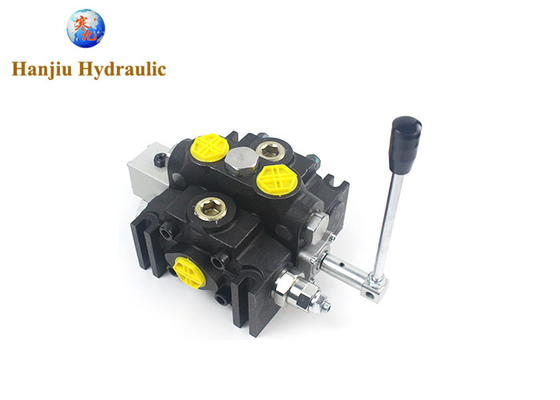hydraulic directional control valve 53gpm DCV section valve, 1 rotary handle spool, manual control type ,SAE ports
DCv200 Manual Directional control vave is an essential component for controline fluid fow in hiph-pressure hvdrauic svstems, Desined for reliable performance. this valve is suitable for use in a variety of industries, including driling machines and sanitation systems.
With its auxiiary valve options,including over-load valve, anti-cavitation vawe, and combined valve, this vave ofers maximum control and precision. The manual control type allows for easy operation and adjustment as needed.
The sectional structure ensures ease of maintenanc and repair, while the cary-over port provides a convenient hydraulic source for other pars ofthe system.
Invest in the Dcv200 Manual Directional control Valve for a reliable and efficjent fluid control solution.
Product Features:
|
Model
|
DCV200 |
| Bank |
1spool
|
| Port |
BSP Port,G1,SAE PORTS,meric ports
|
| Flow and Pressure |
Max. Pressure: 350 Bar
|
| Founction |
Double Acting Cylinder Spool 3 Positions, Spring Return,closed center |


Hydraulic valve is an automatic element operated with pressure oil, which is controlled by the pressure oil of the pressure distribution valve, and is usually used in combination with the electromagnetic pressure distribution valve, which can be used to remotely control the on/off of the oil, gas and water pipeline system of the hydropower station. It is widely used in clamping, control, lubrication and other oil circuits, and is a key element used to control the pressure, flow and direction of liquid in hydraulic transmission. The following is a detailed analysis of the hydraulic valve:
1. Classification
Hydraulic valves can be classified according to different classification criteria:
Classification by function:
Flow valves: including throttle valves, speed control valves, diverter flow collector valves, etc., which are used to control the flow of liquids.
Pressure valves: including relief valves, pressure reducing valves, sequential valves, etc., which are used to control the pressure of liquids.
Directional valves: such as solenoid directional valves, manual directional valves, check valves, etc., which are used to control the flow direction and on-off of liquids.
Classified according to control methods: manual valves, electric control valves, hydraulic control valves
Classified by installation method: plate valve, pipe valve, stacking valve, threaded cartridge valve, cover valve
Classified by operation mode: manual valve, motorized valve, electric valve, hydraulic valve, electro-hydraulic valve
2. Specific functions and applications
Check valve: only allow the fluid to be connected in one direction in the pipeline, and cut off in the reverse direction, which plays a role in preventing the liquid from flowing back.
Reversing valve: change the on-off relationship between different pipelines to realize the direction control of the hydraulic system.
Relief valve: It can control the hydraulic system to maintain a constant state when the set pressure is reached, and is used for overload protection. When the system pressure rises to a limit that can cause damage, the valve port opens and overflows, keeping the system safe.
Pressure reducing valve: It can control the branch circuit to obtain a stable pressure lower than the oil pressure of the main circuit, and can be divided into fixed value pressure reducing valve, differential pressure reducing valve and fixed ratio pressure reducing valve according to the different control pressure functions.
Sequential valve: After one actuator (such as hydraulic cylinder, hydraulic motor, etc.) is acted, other actuators are operated in order.
3. the main points of the design
When designing hydraulic valves, it is necessary to fully consider their functional requirements, ease of installation, ease of maintenance and service life. For example, the length, width and height of the hydraulic valve group are generally determined with reference to the size of the parts that make up the hydraulic valve group, and the channel design should ensure that the length is appropriate and the rotation angle is less to reduce the loss of oil pressure and heat.



 Your message must be between 20-3,000 characters!
Your message must be between 20-3,000 characters! Please check your E-mail!
Please check your E-mail!  Your message must be between 20-3,000 characters!
Your message must be between 20-3,000 characters! Please check your E-mail!
Please check your E-mail! 






